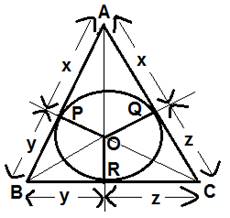In an equilateral triangle of side 12 cm, a circle is inscribed touching its sides. Find the area of the portion of the portion of the triangle not included in the circle. [Take √ 3 = 1.73 and π = 3.14.]

fig.19
Let the radius of the circle be r cm.
In the fig.19,
AR and AQ are making a pair of tangents drawn from vertex A of Δ ABC on the circle.
∴ AR = AQ = x [LET]
BR and BP are making a pair of tangents drawn from vertex B of Δ ABC on the circle.
∴ BR = BP = y [LET]
CP and CQ are making a pair of tangents drawn from vertex C of Δ ABC on the circle.
∴ CP = CQ = z [LET]
Given –
Δ ABC is an equilateral triangle.
∴ AB = BC = AC = 12 cm
⇒ AR + BR = BP + CP = AQ + CQ = 12
⇒ x + y = y + z = x + z = 12…..(1)
Now,
(x + y + y + z + x + z) = (12 + 12 + 12)
⇒ 2 × (x + y + z) = 36
⇒ x + y + z = 18…..(2)
Subtracting equation(1) from equation(2), we get –
x = y = z = 6 cm
Also, the line joining the centre the circle to the vertices of Δ which circumscribes the circle bisects the angles of a Δ.
∴ ∠ OBP = 30°
In Δ BOP,
tan ∠ OBP = OP/BP = r/6
⇒ tan 30° = r/6
⇒ 1/√3 = r/6
∴ r = 6/√3 = 2√3 = 3.46 cm
Area of Δ ABC = (√3/4) × (side)2
=(1.73/4) × (12)2
= 1.73 × 36
= 62.28 cm2
Area of circle = π × (radius)2
= 3.14 × (3.46)2
= 37.59 cm2
Thus, Area of the triangle which is not included in the circle
= Area of Δ ABC – Area of circle
= (62.28 – 37.59) cm2
= 24.69 cm2